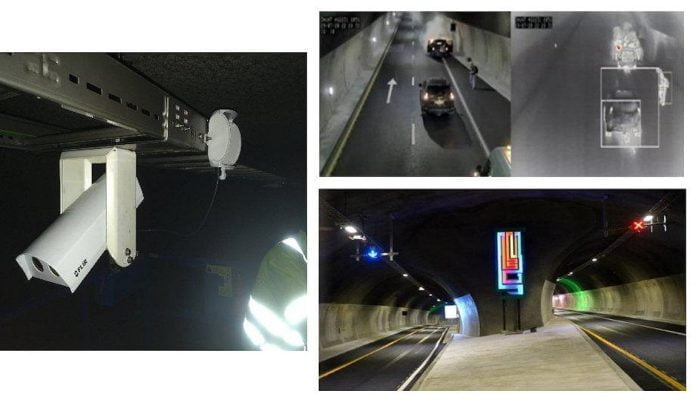Security integrator Trafsys has installed 332 FLIR dual-vision cameras with embedded Automatic Incident Detection (AID) in the new Hundvåg and Eiganes tunnels in Norway. The cameras alert tunnel operators on a variety of possible traffic incidents, including stopped vehicles, lost cargo, and pedestrians, allowing emergency services to react fast.
The Ryfast project consists of 3 tunnels. The 14.4 km Ryfylke tunnel, running from the village of Tau to the isle of Hundvåg, was opened in December 2019. The 5.5 km Hundvåg tunnel, from Hundvåg to Stavanger, was opened in April 2020. The latter tunnel connects with the 3.7 km Eiganes tunnel, which runs beneath the city of Stavanger, as part of the E39 coastal highway. Traffic volumes are 10,000 and 35,000 vehicles daily for the Hundvåg and Eiganes tunnels.
“We were already convinced of the stability of FLIR’s incident detection systems because we have been using them in previous tunnel projects,” says Knut-Olav Bjelland, of Trafsys.
“FLIR’s powerful detection algorithms on visual traffic cameras have proven their performance in tunnel projects worldwide. With FLIR’s dual-vision cameras, we were able to combine the company’s proven video analytics with the power of thermal imaging.”
With the thermal imaging camera, the FLIR ITS Series Dual AID provides critical information on traffic incidents, including stopped vehicles, sudden speed drops, wrong-way drivers, pedestrians, fallen objects, and starting fires. Operators also use the high-resolution (640 x 512 pixels) thermal image to verify the incident and to see where the incident took place.
The use of thermal imaging cameras has especially proven valuable for tunnel entrances and exits. Shadows or direct sunlight could obstruct the view of the visible-light camera and therefore disturb traffic detection. Because they detect heat, not light, thermal cameras have no issues with these phenomena and as a result, they can detect traffic 24/7, in all weather conditions.
“When you look at the complex topography of the Hundvåg and Eiganes tunnels, a camera system like the FLIR ITS Series Dual AID is the most efficient technology choice,” says Knut-Olav. “And with the many bends and turns in both tunnels, you need appropriate detection systems at many different positions.”
The end user is pleased with the system, too.
“The cameras’ daily performance is excellent,” says Anders Helle of NPRA. “We can clearly see the detected incidents on the thermal image in our control room, which reduces the time to understand the situation and speeds up our decision-making process. Based on the system’s reliability, performance, and low unwanted alarm rate, we would definitely recommend the FLIR dual-vision camera for automatic incident detection.”
The dual cameras’ fire detection functionality has also been switched on to demonstrate the early detection capability within seconds of the appearance of visible flames. This could be crucial for tunnel operators to close the tunnel fast and take the necessary decisions in the case of a fire. The thermal technology from FLIR ITS also allows seeing through the smoke. This allows operators to detect the presence of pedestrians and vehicles in a smoke-filled traffic tunnel.
The fire detection functionality was already demonstrated when a car caught fire in the Hundvåg tunnel in July 2020. The FLIR ITS Dual thermal AID camera picked up the fire within 7 seconds after visible flames appeared, following its first alert for a stopped vehicle and pedestrians.
“Apart from the great detection performance we are used to from FLIR, having a combined visual and thermal camera has nothing but benefits,” says Knut-Olav. “Combining both cameras into one detection unit makes it a very compact solution, and cabling is also much simpler.”
#securityelectronicsandnetworks.com









